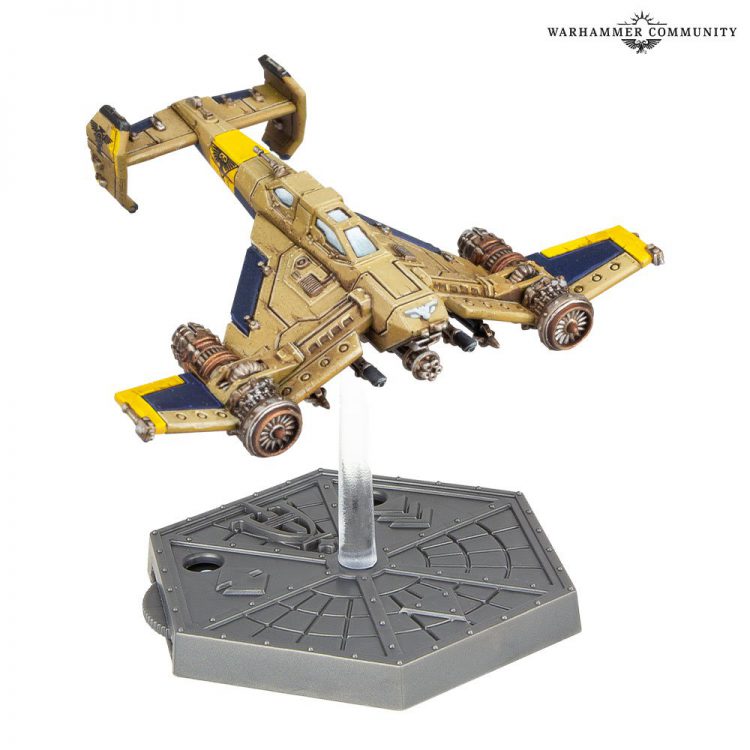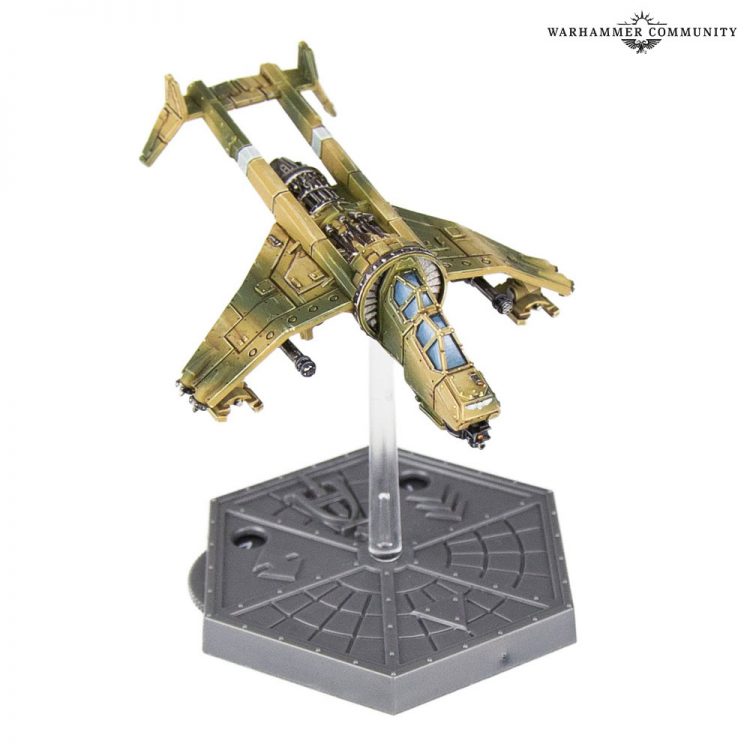I feel I should probably expand on that a little. The Taros Air War book is the shot in the arm that Aeronautica needed, and looks to be a well balanced and much more polished effort that the first campaign book.
The Book
The book follows the same format as the Rynn’s World book: Core rules, background section on the campaign the book is about, scenarios and scenario rules, and squadron lists.
This means anyone new to the game can pick up the book with their faction in (Ork and Tau players) and not have to buy the other book. Since this will likely continue when Chaos and Eldar are released, the only players who can really complain about it are Imperial-only players who could get two books to use all their planes (though to be fair just picking up the cards from the first release will give you all the rules you need).
The Rules
The book includes the full unabridged rules, as did the previous book, with all the rules required for autonomous weapons, ground attacks and strafing and new rules for low level flight and rolling area of engagement.
The rules for low level flight let you add terrain to the game, and you play with a maximum height of 2. This of course means you can crash into things, and that’s where handling becomes really useful as a stat. This is where Avengers and Barracudas with their 2+ handling shine, as this is the stat you roll against to avoid crashing into a building. It’s not so great for Orks, with their best handling stat being a 4+.
Rolling area of engagement lets you play on a trench style board and roll it as you do a trench run or engagement in a valley. It’s interesting and works with low level flight, if you want to do a Death Star scenario you can add obstacles and ground batteries and go a little crazy. You will need 12 by 12 hex squares for this though, which is not something that GW currently sell.
These additional rules support a greater variety in terms of narrative scenarios, and three of the narrative scenarios in the book use these rules.
Low level flight has the largest potential to add to games, and it something I can see modellers having a lot of fun with, as it lets you create buildings, hills, hive city walls and a whole variety of terrain projects. The Adeptus Titanicus kits are a good start with this, and creating pieces of scenery lets you use them in both Aeronautica and Titanicus.
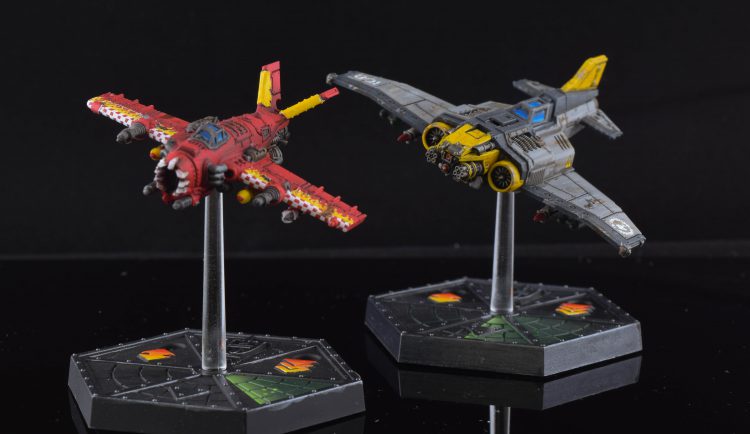
New Scenarios
The biggest weakness of the Rynn’s World supplement was the scenarios, which were very much copied and pasted from the 1st edition AI rulebook.
The Dogfight scenario is unchanged apart from giving you the option to use low level flight. The Dogfight scenario was the most balanced scenario in the original book and the default for quick knockabout games. The demos I’ve run use the dogfight scenario at various point levels because it’s a simple balanced scenario that quickly teaches the game.
New scenarios are The Chase, Subterranean Assault, Sky Fortress Attack and Canyon Attack Run. These are all narrative scenarios that should be treated as such, and you need to accept that you’ll find some scenarios tougher due to the circumstances of the scenario or random factors such as reserve rolls.
However the Skies of Fire starter set also includes a Starter Scenario leaflet with three scenarios: Ambush, Breakthrough, and a fixed Straggler scenario. All three of these are combat scenarios with no bombing or transport elements. These give suggested point values of 50-100 points, and are all suitable for competitive play, giving a core of 4 scenarios that could be used in a tournament format.
The Straggler is still the scenario with the most balance issues out of these new starter scenarios, but the change to the victory conditions vastly improves it. Ambush and Breakthrough are dogfights with different deployments and victory conditions.
The Chase uses Rolling Area of Engagement to have two aircraft racing through a canyon or valley trying to shoot each other down with the rest of the aircraft joining as reinforcements throughout the scenario. You can use low level flying as well to make it more interesting.
Subterranean Assault fights a battle using the low level engagement rules and the attacker has to land troops near the defender’s board edge. Terrain pieces make the game more interesting, allowing players to obstruct firing lanes. The scenario also uses the rules for Night Fighting, preventing long range fire and halving the dice rolled for medium range. This means close ranged battles and the handling stat become important.
Sky Fortress Attack is an assault on a fortified structure like a space elevator. This structure can buy 40 points of ground defences for free, which is a little unbalancing in smaller games (the scenario specifies 100-250 points per side). I think this could get quite tough for an attacker, though Skystrike missiles at long range, Tau AX-1-0 Gunships with Heavy Rail Cannon or Vendettas can plink away at long range to wear them down. This is an interesting scenario I would recommend playing on a large map.
Canyon Attack Run has the attacker running down a canyon using the rolling area of engagement rules and low altitude. The attacker has to take out ground targets, and as new board sections are placed as the engagement rolls forward, new ground targets are placed. This scenario will involve the attacker trying to move the map forward and blow away as many ground targets as they can in 12 turns. This gives players the opportunity to repeatedly say ‘Stay on Target’.
It’s worth noting that the scenarios in the book are not trying to be competitive scenarios as much as they are trying to be interesting, and I think they succeed in that.
The additional scenarios in the starter set are meant to be more balanced scenarios to play out of the box and I would recommend these and the Dogfight scenario to beginners.
Campaigns
This is almost exactly the same as the campaign section in the Rynn’s World book. There are Ace abilities for Tau and Astra Militarum (so Navy or Ork players need the Rynn’s World book or cards from that release) but the progression and generation of Ace abilities is exactly the same.
An interesting foot note is the example in replacing planes which says that a Lightning with three sets of Skystrike Missiles and a Lightning Strike with two sets of missiles costs the same, which indicates the multilaser upgrade on the Lightning was 2 points at some point in playtesting and editing passes missed changing this
Imperial Navy
The Imperial Navy get access to three new planes, the Avenger, Lightning and Arvus.
Avenger Strike Fighter
This fighter has an Avenger Bolt Cannon on a structure 2 body. While it weighs in at 20 points with no upgrades, it has two ordnance slots and can purchase either a twin lascannon or twin autocannon for three points. You’ll generally buy the lascannon, though the autocannon has it’s uses if you’re playing on a terrain heavy board in a low level flight game and you aren’t going to be using long range fire.
This means that for 23 points you can get a fighter with one less structure than a Thunderbolt Fury and less bolt cannon dice (2-5-0 vs 3-7-0). So what do you gain?
With handling 2+ the Avenger is great for low level flight, able to not crash into things most of the time. This makes it the best choice in a number of missions. It’s also got enough dice to throw to be a decent dogfighter and strafer.
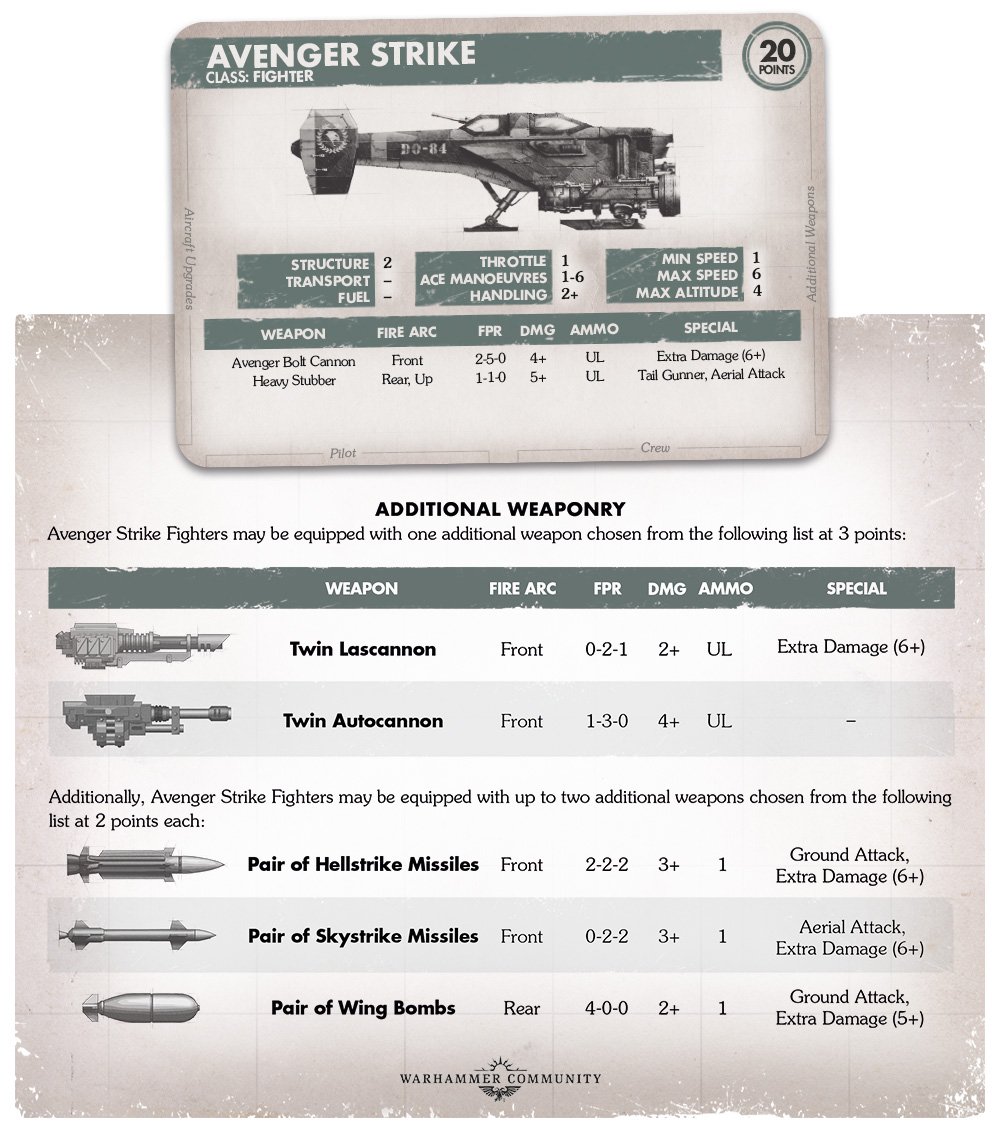
Lightning and Lightning Strike Fighter
This is a lighter dogfighter. Capable of Speed 8 and manoeuvre 1-7, this fighter can outmanoeuvre and outrun pretty much every other fighter in the game. It can keep up with Dakkajets, and has better handling and manoeuvring. The 19 point Lightning is armed with 2 lascannons, and can upgrade to multilasers for 4 points with 4-6-2 and 5+ damage, which gives you the ability to hit targets at any range.
Whether the Lightning Strike is worth 23 points is a subject of debate, that I’ll talk about a lot more when we discuss balance. It’s clear that at one point the Lightning Strike was meant to cost 21 points, and it changed at some point in development.
What will be interesting is if players change how they play. Imperial players have had a pretty good hammer in the form of the Thunderbolt Fury. The Lightning Strike is more like a scalpel, and the question is whether we will see a new set of tactics based more on manoeuvre and speed rather than toughing things out and hitting them with twin Avenger Bolt Cannons.
Arvus Lighter
This is a scenario aircraft. It is worth noting that this is the first plane in the game to have a Fuel limit (in this case 6 turns). This is a cargo plane with no guns (the armed version from 1st edition has not made it into 2nd edition) and a transport of 3. However the 6-turn fuel limit massively restricts its use. In scenarios you create you can of course change this, and escort Lighters through a canyon, or support them in dropping off material to the Astra Militarum or evacuating key personnel as a planet falls to the xenos.
The Arvus can however manoeuvre as well as a Thunderbolt and keep pace with them, so it is able to go faster than a lot of transports. It is also only 10 points which means it can be used as an initiative sink in games where it is present. It has jump troops so you can fly over the LZ and push people out the door if you fancy taking the risk of some of them going squish.
This is also a resin aircraft that will be available from Forgeworld. We haven’t seen how many you get in a pack yet.
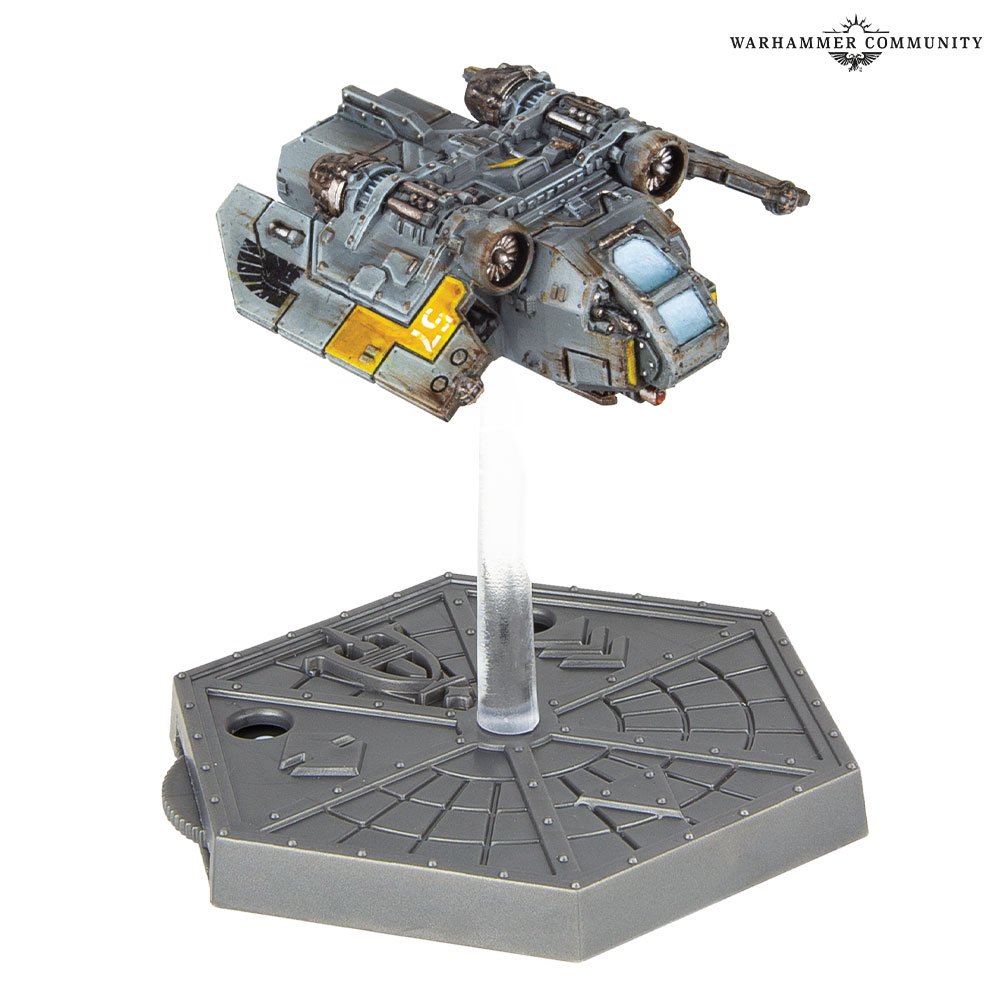
Astra Militarum
The Astra Militarum have their own upgrades list. Three of these (Flares, Armoured Cockpit and Imperial Ace) are exactly the same, with two new ones Armoured Transport Compartment and Tactical Targeting Array.
Armoured Transport Compartment lets you, on a 5+ roll, reduce the victory points your opponent scores for destroying that plane by 25%. I wouldn’t personally take this, as you pay 2 points for a 33% chance to give your opponent maybe 5 or 6 less victory points if they blow it up.
Tactical Targeting Array lets you, once per game, reroll all ones when it attacks an enemy aircraft. This costs 3 points and while it isn’t as good as the Ace ability, is worth it on a Vulture with Punisher Cannons rolling 11 dice at medium range when your dice hate you and you get a big pile of ones.
The Imperial Navy get all Militarum aircraft and it very explicitly says this at the beginning of the Astra Militarum section.
The Three Vs (Valkyrie, Vendetta and Vulture)
These aircraft are actually enough to play every scenario given you have transport and anti-ground target capacity, and it could be really interesting to put together an Imperial Guard Drop Force. I would actually love to see this as a force, and it would be interesting to play and to play against. It wouldn’t be fast, but it would be very different to any other force.
The tactics would be completely different. With a maximum speed of 5 and a minimum of 0, you have a lot of firepower but lack the speed to choose the engagement distance. You’re vulnerable to fast planes using stall turns to get behind you so you need to use a layered formation with your aircraft. This is not a bad idea as you have good medium and long range firepower available to you (but as an Imperial player it is best to be at medium range). Valkyries at the front, Vendettas at the back and Vultures at the flanks able to take advantage of the 1-8 maneuvers that they have.
Valkyries/Vendettas
Armed with a lascannon, multilaser or twin lascannon (depending on the upgrade you choose), this is a lightly armed transport craft that can Hover at speed 0 and has a Transport of 3.
What this means is that Imperial players now have a good solid transport that can drop Jump Troops and be used for missions where you need to land or pick things up. At 16 points you can keep them cheap, but you have the options to load up on rocket pods, skystrikes or twin lascannons in order to have either ordnance (and rocket pods are interesting as a 2-6-2 5+ Damage Ammo 3 Ordnance option) or convert to a Vendetta at 21 points and have six lascannon shots at medium range.
Vendettas give you a sniping unit with three lascannon dice at long range and six dice at medium range. With three structure the unit is relatively tough.
Vultures
With throttle 2 and maneuvers 1-8 and max speed 5 these gunships can move better than any other plane in the game. With jink (which lets you slide a hex in any direction with no change to speed or facing when you select them to fire) you can start in one range bracket and slide into another when you choose them to fire.
These light gunships can take a large variety of wing weapons. Punisher Cannons come in at 4 points, giving you unlimited ammo 6-10-0 5+ weapons. You can take two rocket pods to throw 12 dice at medium range, but missile cradles may be the ultimate ordnance choice. You can take two, at three points each, giving you ammo 3 missiles.
This lets you throw out 4 missile dice for three turns. On a structure 2 plane it won’t necessarily last more than three turns in combat so you have to weigh up the benefits of paying 26 points for a Vulture with missile cradles vs 24 points for a Punisher Vulture.
In low level flight scenarios with terrain the things a Vulture can do are valuable, but in standard scenarios you are a max speed 5 plane vulnerable to faster planes.
Hydra Flak Battery
This is exactly the same as the Hydra Battery in the Rynns world book, but with different art it appears that there will be a new miniature.
At 8 points for a 6-4-2 damage 5+ Altitude 2 gun this is a good defence battery for a ground target.
If you are equipping a Sky Fortress in the scenario, then buying five of these is a perfectly valid defence plan.
This is also the AA gun of choice in low level flight scenarios.
Basilisk Anti-Aircraft Emplacement
This 9 point battery can hit aircraft at any height, and is 1-2-1 Damage 2+ (Extra Damage 6+) Altitude 4. It does what it says on the tin.
Megena Ayce
An Ace Lightning pilot who can change their order counter once per game. This costs three points more that the standard Lightning and is worth it for the ace ability.
Dyce Vander
A Valkyrie pilot who can once per game reroll their dice for deployed jump troops. The Valyrie has the twin lascannon upgrade and can still purchase wing weapons, so the ace ability costs two points and is really only useful in troop drop missions.
The Perfidious Forces of the Tau
The Tau forces are not as numerous as I had hoped, with the Orca and Manta not included. The Tau have Barracudas, Tiger Sharks, Tiger Shark AX-1-0 Gunships and Remora Drone Fighters. Transport is provided by the Tiger Shark, which has transport 2.
The Tau upgrades are Decoy Drones (flares/chaff), Infra Red Targeting, Armoured Cockpit and Kor’El (Tau Ace) which are all the same as the Imperial upgrades.
There are two specific Tau upgrades: Defensive Drones and Ionic Afterburners.
Defensive Drones gives an aircraft a short range 1 dice tail gun with 6+ damage, like the tail gun on the Ork Fighta Bommer. This costs 1 point, and is probably worth it on Tiger Sharks and Plasma Gunships that are likely to end up in close range brawls.
Ionic Afterburners is a 2-point upgrade for Barracudas that give them max speed 7 and 3 throttle. This gives them a higher speed and throttle than Thunderbolts.

Barracuda Fighters
These structure 2 fighters have throttle 2 and max speed 5, but maneuvers 1-7. With handling 2+ they are great for low level flight.
With the option for three different main guns – swiftstrike railguns, swiftstrike burst cannons and ion cannons. In terms of efficiency the railgun and burst cannon have similar damage output, but the burst cannon can hit targets at every range bracket, while the railgun can only hit medium and long range targets.
Barracudas have missile pods (1-3-1 4+ damage) and can pay 3 points for drone turrets.
Drone turrets are another area where Barracudas have advantages over other fighters. These have 360 degree arcs at the same level and down. While you can attack from one altitude level higher and avoid these turrets, they are incredibly useful for Barracudas. I can’t see a circumstance where I wouldn’t take these turrets.
This effectively means the Barracuda costs between 25 to 29 points, and you have six possible loadouts. You can also purchase air to air seeker missiles for two points which are the same as skystrikes.
The question is whether the burst cannon turret (0-3-2 5+ Damage) or Cyclic Ion Cannon (2-1-0 4+ Damage) is better with the main gun you’ve chosen, and whether you take something that compensates for weaknesses in the main gun, such as matching Cyclic Ion Cannons and Railguns, or something that gives you more dice in your strongest range bracket, like Swiftstrike Burst Cannons and Burst Cannon turrets, which have 9 burst cannon dice and 3 missile pod dice at medium range.
Barracudas are pricey, and giving them lots of upgrades puts them in the same price bracket as Tiger Sharks, who, when armed with railguns and turrets come in at 27 points.
This is what Tau players need to decide: Do you get a Barracuda with turrets and ionic afterburners for 27 points or buy a bare bones Tiger Shark with turrets for the same points?
Tiger Sharks
These are what I’d choose as the backbone of my Tau force. With maneuver 1-4, max speed 5 and structure 5, they can maneuver like Ork Fighta Bommers. In the tactics article I wrote I talked about the bomber destroyer concept and this is a perfect aircraft to try this with.
The basic Tiger Shark with turrets is 27 points. You can swap the main armament from railguns to ion cannons for +2 or burst cannons for +8. Burst Cannons and Ion Cannons have dice at all ranges, and as a slower aircraft being able to hit targets at any range can be a good idea. Of these two options I would choose ion cannons and I’d probably pair them with cyclic ion cannons, to give you 6 dice damaging on 4+ at medium range for 29 points. Similarly the defense drones and armoured cockpit upgrades are viable upgrades.
These are also the only Tau units with transport, so are invaluable in scenarios requiring it.
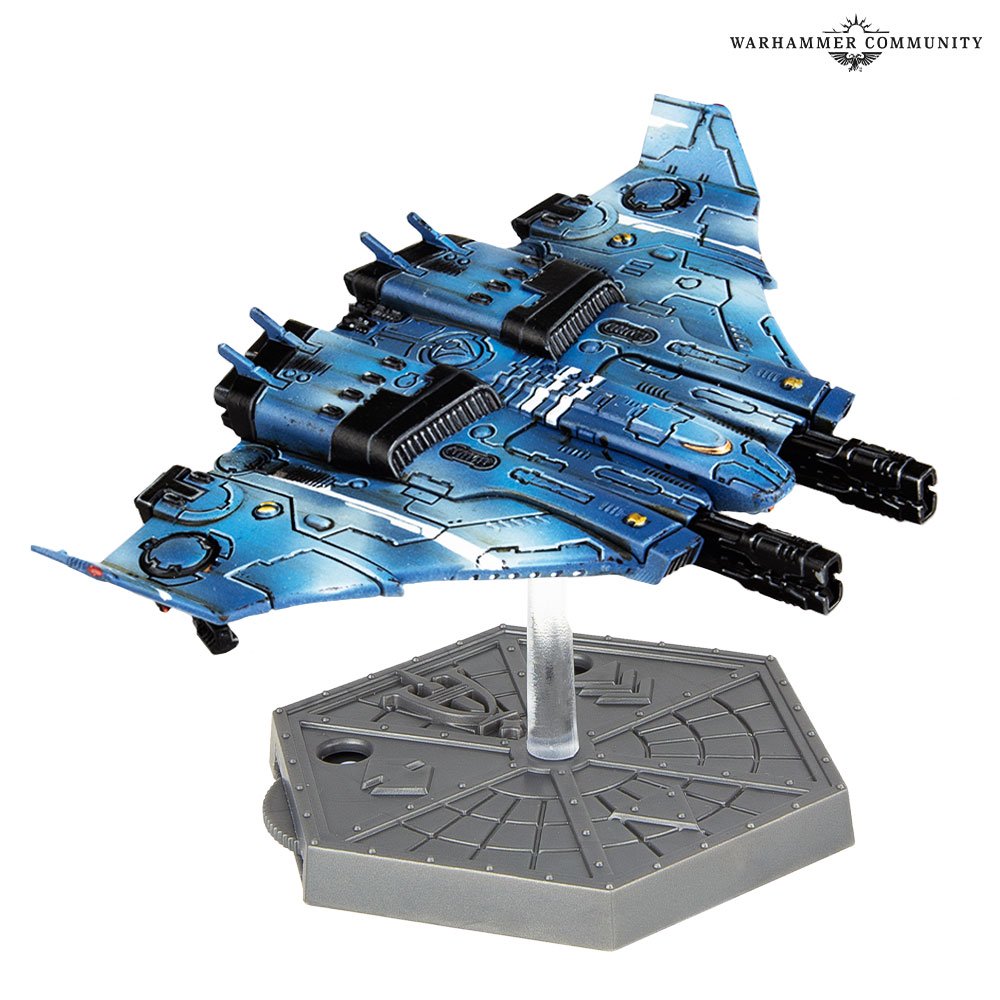
Tiger Shark AX-1-0 Gunships
These Tiger Shark variants lose the transport capacity but gain a point of max speed, making them faster than Barracudas without afterburners.
Packing heavy railguns (0-2-3 2+ Damage, 5+ Extra Damage) these are long range snipers. Long range sniping is difficult to pull off, but you can switch to Heavy Plasma Accelerators (4-2-2 3+ Damage, 6+ Extra Damage) for close range punch. If you are facing large and slow targets (Eavy Bombers for instance) then closing and pounding with Plasma and Cyclic Ion Turrets is viable, particularly when you are speed 6 and they are speed 4.
Speed 6 also lets you chase down marauders. I think that a mix of gunships and Tiger Sharks with a handful of lighter units is a perfectly viable force.
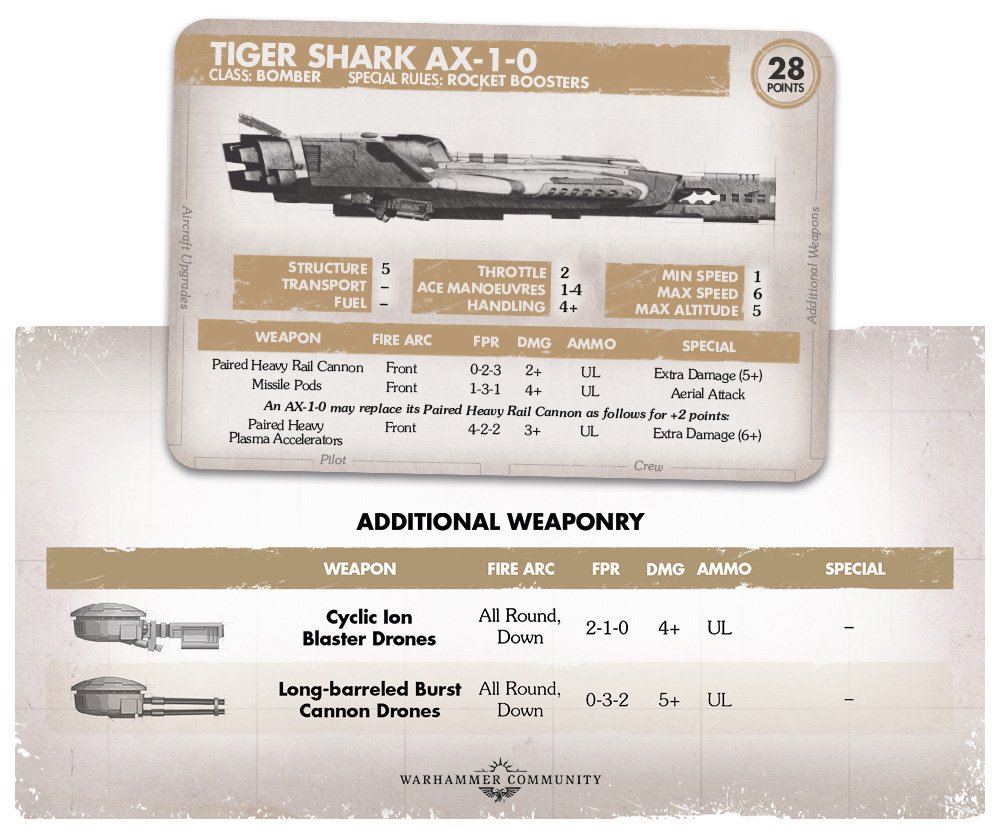
Remora Drone Fighter
We don’t yet know if this is a plastic kit or another FW resin, as we haven’t seen a preview. I’m hoping for plastic.
At 14 points this fighter has Jink, just like the Vulture, and comes with burst cannons (4-2-0 Damage 5+) and Seeker Missiles (1-2-1 Damage 3+, Extra Damage 6+ Ammo 2). You also have Stealth to count as 1 altitude level higher when targeted by ground fire.
The Remora is a good close range escort, with maneuver 1-7, max speed 6 and throttle 2, but dies to a sneeze with structure 1.
Using cheap Remoras as an initiative sink is entirely possible, and the ability to maneuver better than most other fighters and Jink helps keep them alive. Remoras live by minimizing the shots they take, and Jink is great for that.
I can see a Remora squadron being interesting to play, especially in a game with terrain.
KV 126 Skyfire Platform
This burst cannon platform is good for low level flight games, with 4-10-0 5+ damage Altitude 2, but it is most suitable for missions with ground targets or landing zones where planes have to come into certain areas of the table and close to the ground. It is 9 points, making it quite expensive for a ground asset.
KV 129 Stormfury Platform
This is the heavy platform for the Tau, despite being 7 points. With 1-2-2 2+ Damage 6+ Extra Damage Altitude 4 you are basically trying to plink away at aircraft, and you can hit any altitude and have 2 dice at long and medium range.
Kor’La Kae O’Ar
The Tau Barracuda ace essentially lets you use Jink once per game for the cost of 2 points. However it prevents you taking any aircraft upgrades. I am unsure as to whether this is worth it. It can make a massive difference in terms of a single turn by sliding between one range bracket and another or out of a fire arc, but you need to decide if it’s more useful than Ionic Afterburners.
Kor’La Dor’n O’Ka
The Tiger Shark ace gains a 5+ save once per turn against taking a point of structure damage. This costs 2 points as there is already an ion cannon upgrade taken. This may be better than armoured cockpit, which costs 3 points for a 6+ save against all damage, but I think the size of the engagement has an effect on this. In smaller games you may have less damage incoming because there are fewer enemy planes, but in larger games where it’s more likely that a target plane will take multiple strikes it is less useful if you have 3 or more damage points coming in a turn.
I think this is a good Ace to take in games of 150 points or less, and a cheap Ace compared to a flat Ace upgrade or Armoured Cockpit upgrade. It will come in at 31 or 33 points (if you take a seeker missile bay) making it one of the most expensive Aces in the game, but only 2 points of that cost is the Ace ability.
The Problem of Choice
The problem of choice in our society is a massive one, from Tinder swiping to Tau main gun options. Obviously since I’m married now only one of these affects me, but that’s a discussion for another time.
The Barracuda and Tiger Shark have six possible configurations, the gunship four. Barracudas can be upgrade to a high speed, high power interceptor for 2 points.
And the question you have is, is this the option to take? I would recommend playing some games. Find the style you like and go from there. Long range duelist and medium range brawler Tau are both practical choices. A Tiger Shark fleet or Remora swarm both look interesting to try.
Balance
There has been a lot of discussion about balance with Wave Two. In Wave One the Thunderbolt, and particularly the Thunderbolt Fury, dominated. It was the most manoeuvrable plane (1-6) with the best damage output per point of any aircraft in the game. On average it would chew through a structure 2 aircraft at medium range in a single turn. This pushed Ork players towards a Fighta Bommer meta as they could generally take a turn of Fury fire and fire back.
With the release of Lightnings and Barracudas we now have manoeuvre 7 aircraft which (with upgrades in the Barracudas case) can outpace and out accelerate/decelerate Thunderbolts. These are expensive in comparison though, with the Lightning Strike costing the same as a Fury and a Barracuda with upgrades costing significantly more.
The designer very clearly values the ability to move in the game space more than sheer firepower, and the ability to hit at any range is similarly valued. This makes both of these new fighters quite expensive, to the point where Tiger Sharks run as heavy fighters becomes a viable build for the Tau (similarly to Orks with Fighta Bommers run as fighters).
We also see aircraft with Jink for the first time, which I think is a great screw you ability, particularly in low level flight games where you can use it to either hide behind or pop out from terrain to prevent you from taking fire. I can see Eldar getting this ability on their fighters, which I see as a possibility because of Eldar perfidiousness and the aggravation it would cause all non-Eldar players.
I think we’ll need to see a lot of games played at different points levels. I think speed and manoeuvrability is more useful in small games where you can pull off clever moves and your opponent can’t just move their third Thunderbolt Fury into medium range and go brrrt.
I also think, with throttle 3 fighters available, we’ll see more use of height to stagger planes and avoid incoming fire as with the ability to accelerate or decelerate let’s you move from a leisurely Speed 3 or 4 to maximum with a dive in a single turn. You can drop from Speed 8 to Speed 4 by climbing a level and let enemy aircraft tear past you and then tail them. This make aircraft less predictable, which is an issue with Ork planes and their limited manoeuvres, especially their heavier units.
Whether we’ll see a repetition of the power fighter tactics of WWII I don’t know. This was where pilots in things like P-47s or late model Spitfires or Mustangs used their superior power to tear through enemy formations repeatedly as oppose to planes like the Zero using their manoeuvrability to dogfight. This is because these new high-speed fighters are also more manoeuvrable than the previous top dogs, Thunderbolts.
I forsee a big meta shakeup. With the Imperial Navy more than doubling the number of planes available to them Imperial players can forgo the 2 Marauder Destroyer 3 Thunderbolt Fury build for 125 point games and play something more interesting. I think the additional scenario pack from the starter set, with it’s recommended 50-100 point games, gives a first impression of what GW would like to see in competitive play, and given it’s a 4 page leaflet and not in the book, it’s obviously a course correction based on feedback to Wave One.
Example Forces
Here’s a couple of example 125 point forces based on themes. Aeronautica is a game where you can definitely theme your squadrons, and experiment with any colour scheme you like.
Astra Militarum Force – Elysian Drop Platoon – 125 Points
This force represents an Elysian Platoon with a supporting Vulture section.
Vulture – Punisher Cannons – 24 points
Vulture – Punisher Cannons – 24 points
Vendetta – Twin Lascannons – 21 points
Valkyrie – Twin Lascannons – 20 points
Valkyrie – Rocket Pods – 18 points
Valkyrie – Rocket Pods – 18 points
Tau Gunship flotilla – 125 points
This represents a Tau heavy strike force.
Kor’La Dor’n O’Ka – Tigershark with Ion Cannon, seeker missile bay, Cyclic Ion Blasters – 33
Tiger Shark AX-1-0 – Heavy Plasma Accelerators, Cyclic Ion Blasters, Defensive Drones – 34
Tiger Shark AX-1-0-4 – Ion Cannons, Cyclic Ion Blasters, Defensive Drones – 30
Remora Drone Fighter – 14
Remora Drone Fighter – 14
Final Thoughts
Wave Two is the injection of new content that Aeronautica needed, adding a new faction and nine new planes to the game. This has already brought in new players as people have picked up the game to play Tau. We have our first Structure 1 fighter, introduce jink, our first 1-8 manoeuvre aircraft, and shake up the fighter meta with more high speed interceptors. I hope to see Thunderbolt Furies dethroned as kings of the skies and new strategies and metas evolve. We have four aircraft still to be released, with at least Avengers a plastic kit, and we’ll have to figure out if you can magnetise Vultures.
I’m looking forward to seeing new schemes for planes, and exciting new things that people can do to add terrain to low level flight games, which will create a new meta all of it’s own.
This makes me really excited for Wave Three as well, and I’m looking forward to that when it comes, though given events in the wider world, I won’t be incredibly surprised if that isn’t until 2021.
Have any questions or feedback? Drop us a note in the comments below or email us at contact@goonhammer.com.

